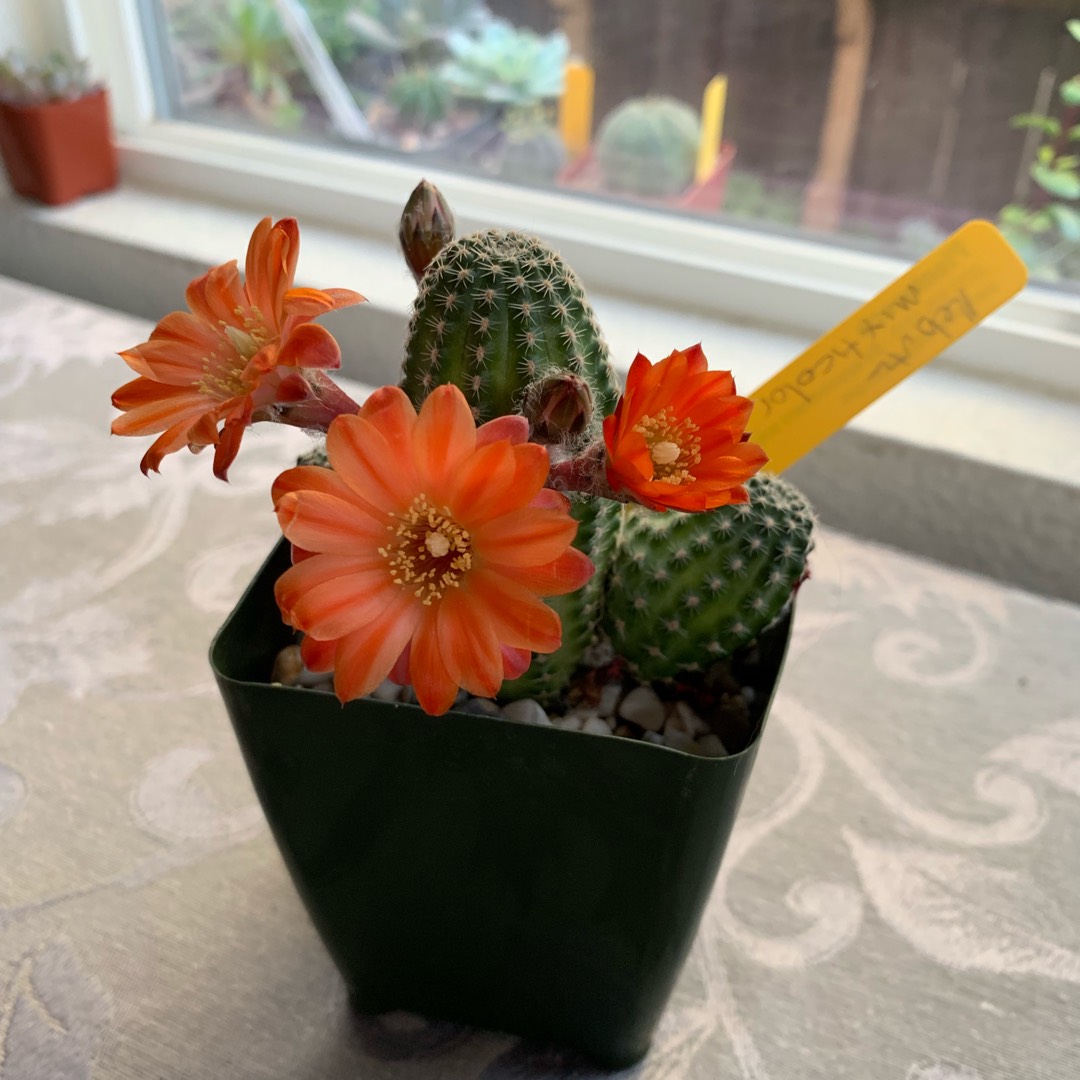
Rebutia Mixticolor
Rebutia 'Mixticolor'
Rebutia are small, attractive cacti, globular in form that usually form a small clump. They freely produce flowers that are relatively large in relation to the body. Flowers are funnel-shaped with floral tubes that often extend and curve upwards over the plant. They have no obvious ribs, but do have regularly arranged tubercles. They are fairly easy to grow and may produce large quantities of seeds that germinate freely around the parent plant. They are extremely well adabted to drought and able to store water within their structure to ensure survival through dry periods. They are often grown in greenhouses, particularly in regions unsuited to their cultivation outdoors. They can be grown in the ground or in suitable containers which means that they are suitable as houseplants, being tolerant of the often dry atmosphere.
-
Full sun
-
Very little water
-
A little frost hardy: 32F (0°C)
-
Light and free draining
Common name
Rebutia 'Mixticolor'
Latin name
Rebutia Mixticolor
type
Cactus
family
Cactaceae
ph
5.0 - 7.0 Acid - Neutral
Plant & bloom calendar
-
Best time to plant
full grown dimensions
 0.20 M
0.20 M
0.20 M
0.20 M
Rebutia Mixticolor
Rebutia are small, attractive cacti, globular in form that usually form a small clump. They freely produce flowers that are relatively large in relation to the body. Flowers are funnel-shaped with floral tubes that often extend and curve upwards over the plant. They have no obvious ribs, but do have regularly arranged tubercles. They are fairly easy to grow and may produce large quantities of seeds that germinate freely around the parent plant. They are extremely well adabted to drought and able to store water within their structure to ensure survival through dry periods. They are often grown in greenhouses, particularly in regions unsuited to their cultivation outdoors. They can be grown in the ground or in suitable containers which means that they are suitable as houseplants, being tolerant of the often dry atmosphere.
Planting outdoors
From Early Spring TO Late Spring
Only a select few cactus will survive outside in temperate climates, because of winter rains and low temperatures. In selecting plants for use outside, one must look at the habitat from which the plant originates. It must have sun most of the day. Morning and afternoon sun is better than two o clock sun. The area should have very good drainage, this is more important in the winter than the summer. Most cactus are not killed by the cold, but when the water inside the plant freezes it expands and splits the outer layer of skin, this allows bacteria to enter the plant and kill it.
Propagation
From Early Spring TO Late Summer
Rebutia cacti can be propagated easily from offsets, which readily form in clusters around the base of the mother plant. These clump-forming species readily produce offsets which can be lifted and divided. Once your plant has gained a decent size and has sent out several offsets, carefully remove the offset and allow the cut to dry on a paper towel for a few days. Depending on the size of the cut area, a callous will form over the cut surface. Once the callous has formed, place the new plant in a pot with a potting soil mixture and keep in a warm place until new roots emerge.
Planting in pots
From Early Spring TO Late Winter
Potting mixes can be made by mixing one part potting mix, one part washed sand & one part course fill (rocks, pumas, broken pots, etc.) Don`t worry too much drainage is better than not enough. When planting the cactus never dig a deep hole down in the potting mix. You want the plant to set on top of the potting mix, this allows the roots to go down to get moisture with out the plant setting in wet soil. A potted cactus will live and flower in the house if given enough light, place the plant near a bright lighted window, where it will receive light most of the day. On the patio is different place the cactus in a partly shaded area until it become accustom to the sun.
Propogation by cuttings and offsets
From Early Spring TO Late Winter
Most cuttings require time to dry and produce a callus on the wound, this can take from a week to a day depending on size and type. Use John Innes No 1 with up to 30 percent by volume of added grit and keep the compost on the dry side to prevent the cutting rotting off. Always check what your individual specimen will require.
Propagation by seed
From Early Spring TO Late Spring
Rebutia can also be grown from seed; Use John Innes No 1 with added grit or sand for added drainage. Sow the seed in spring. Large seed will need a covering of one to two times the depth of the size of the seed. Small fine seed should not be covered, but mix the seed with a little sand to help with an even distribution. Water with a misting bottle or a watering can with a fine rose and cover the pot with a sheet of glass or plastic bag. Keeping them at 21°C in partial shade. Allow air into the pot daily by removing glass or plastic bag and wiping off condensation. Keep moist but not overly wet. Pot on seedlings when they are big enough to handle. It can take up to 12 months for them to reach this stage.








